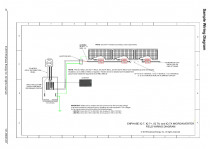Greetings all I have only ever installed a dozen or so microinverter systems, and always have used 20 amp branch circuits and 12/2 wire (perhaps also 10/2 for voltage drop).
I have a job where another electrician roughed in a nice beefy 8/2 romex for the 'future solar' and now that the future is here and the solar is being installed I put it on a 30A breaker, just because I had it in the van, then I got to thinking I have never used a circuit larger than 20 Amps so I looked over the enphase documentation figuring I would see something saying I need a 20 Amp circuit max but instead it says:
5 "Limits may vary. Refer to local requirements to define the number of microinverters per branch in your area."
In my area its pretty much just the NEC, Is there anything in the NEC that limits the microinverters branch circuit to 20 amps?
For this particular system its tiny only 3.7 kVA, but I was thinking of larger systems in the future.
Thanks in advance and happy friday
I have a job where another electrician roughed in a nice beefy 8/2 romex for the 'future solar' and now that the future is here and the solar is being installed I put it on a 30A breaker, just because I had it in the van, then I got to thinking I have never used a circuit larger than 20 Amps so I looked over the enphase documentation figuring I would see something saying I need a 20 Amp circuit max but instead it says:
5 "Limits may vary. Refer to local requirements to define the number of microinverters per branch in your area."
In my area its pretty much just the NEC, Is there anything in the NEC that limits the microinverters branch circuit to 20 amps?
For this particular system its tiny only 3.7 kVA, but I was thinking of larger systems in the future.
Thanks in advance and happy friday


